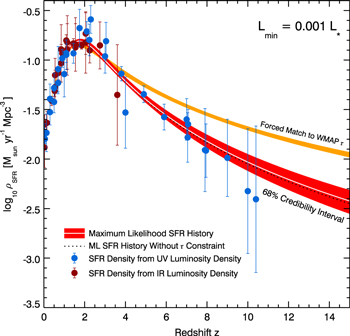We discuss new constraints on the epoch of cosmic reionization and test the assumption that most of the ionizing photons responsible arose from high-redshift star-forming galaxies. Good progress has been made in charting the end of reionization through spectroscopic studies of  6–8 QSOs, gamma-ray bursts, and galaxies expected to host Lyα emission. However, the most stringent constraints on its duration have come from the integrated optical depth, τ, of Thomson scattering to the cosmic microwave background. Using the latest data on the abundance and luminosity distribution of distant galaxies from Hubble Space Telescope imaging, we simultaneously match the reduced value
6–8 QSOs, gamma-ray bursts, and galaxies expected to host Lyα emission. However, the most stringent constraints on its duration have come from the integrated optical depth, τ, of Thomson scattering to the cosmic microwave background. Using the latest data on the abundance and luminosity distribution of distant galaxies from Hubble Space Telescope imaging, we simultaneously match the reduced value  recently reported by the Planck collaboration and the evolving neutrality of the intergalactic medium with a reionization history within
recently reported by the Planck collaboration and the evolving neutrality of the intergalactic medium with a reionization history within  , thereby reducing the requirement for a significant population of very high redshift (
, thereby reducing the requirement for a significant population of very high redshift ( ) galaxies. Our analysis strengthens the conclusion that star-forming galaxies dominated the reionization process and has important implications for upcoming 21 cm experiments and searches for early galaxies with the James Webb Space Telescope.
) galaxies. Our analysis strengthens the conclusion that star-forming galaxies dominated the reionization process and has important implications for upcoming 21 cm experiments and searches for early galaxies with the James Webb Space Telescope.
The full paper can be found in Robertson et al. 2015, ApJ, 802, 19

Star formation rate density with redshift. Shown are the SFR densities from Madau & Dickinson (2014) determined from infrared (dark red points) and ultraviolet (blue points) luminosity densities, updated for recent results and extrapolated to a minimum luminosity . A parameterized model for the evolving SFR density (Equation (2)) is fit to the data under the constraint that the Thomson optical depth τ to electron scattering measured by Planck is reproduced. The maximum likelihood model (white line) and 68% credibility interval on (red region) are shown. A consistent SFR density history is found even if the Planck τ constraint is ignored (dotted black line). These inferences can be compared with a model forced to reproduce the previous WMAP τ (orange region), which requires a much larger at redshifts .
